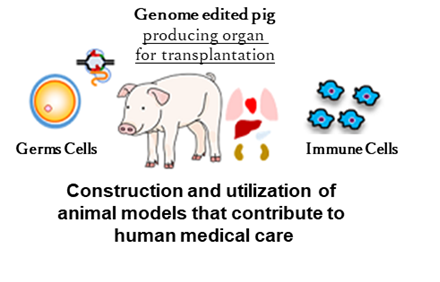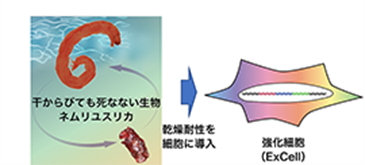In recent years, the demand for pigs as experimental animals for medical research has been increasing. Demand for model pigs that reproduce human diseases is also increasing, and development using genetic recombination and genome editing technologies is in progress. In addition, there is a huge demand for miniature pigs to save space and cost. NARO has jointly developed model pigs with hyperlipidemia, hemophilia, and immunodeficiency, and these are used to study diagnostic and therapeutic methods. Furthermore, we are promoting the miniaturization of immunodeficiency pigs with a perspective of using them in regenerative medical research, and we aim to promote their utilization in the medical research field.
We are working to improve the efficiency of model pig development by utilizing genome editing technology, which shows remarkable progress. Simultaneously, we are developing new control, preservation, and utilization technologies for germ cells and early embryos to establish systems that allows us to use biomaterials for genome editing at any time.
We have also established a method to produce immortalized cell lines from macrophages, a type of innate immune cells, in pigs. By utilizing this system as a model system, the functional analysis of various pathogens in pigs and the development of vaccines are expected to progress. We are also exploring the relationship between genetic diversity and resistance to infectious diseases and are aiming to develop strains of pigs with excellent disease resistance.

And, we focuse on biomaterials and the special functions of living organisms and is engaged in research to make advanced applications of them.
Larvae of the insect Polypedilum vanderplanki have an ability to regain active life by rehydration even after they were completely desiccated. To clarify the molecular mechanism of this phenomenon, the draft genome was sequenced, and the specific genome structures related to the desiccation tolerance was discovered. Through the elucidation of the unique function of this insect, we have identified genes responsible for its tolerance to desiccation and we are engaged in the development of a new preservation technology for biological samples (E.G., food enzymes, live vaccines, animal gametes) at room temperature using these genetic factors.

Members
- TAKENOUCHI Takato (Leader)
- KIKAWADA Takahiro (Deputy Leader)
- FUCHIMOTO Daiichiro (Deputy Leader)
- Richard Cornette
- SHIMURA Sachiko
- YOSHIDA Yuki
- YOSHIDA Mizuki
- Tamas Somfai
- TANIGUCHI Masaaki
- HARAGUCHI Seiki
- SEMBON Shoichiro
- SUZUKI Shunichi
- NAKAI Michiko
- NAGAI Hiroki




